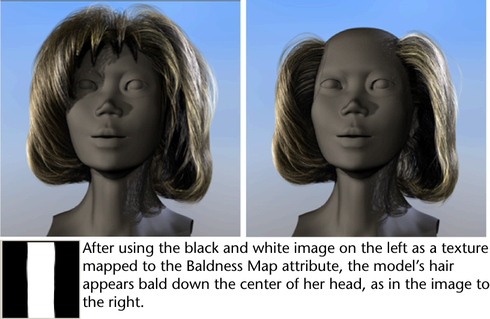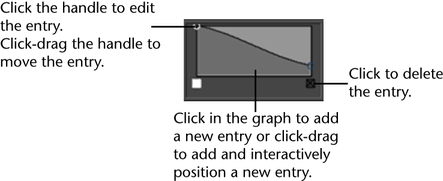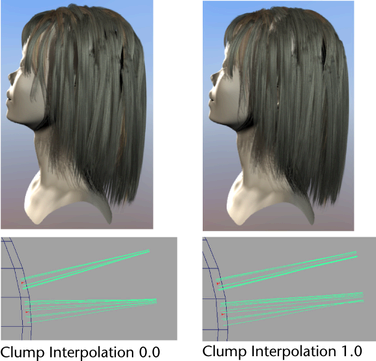This section contains attributes to control the hair clumps and overall hair shape.
- Hairs Per Clump
-
This is the number of hairs rendered for each follicle.
- Baldness Map
-
Reduces the hair density using a texture. The texture used must be a 2D texture.

- Sub Segments
-
This determines the number of smoothly interpolated segments at render time. The hermite interpolation smooths the shape of the line, in addition to providing more detail for curls and fine features. The added segments affect the rendered look only and do not affect the dynamic simulation.
- Thinning
-
This controls the proportion of shorter length hairs.
- Clump Twist
-
This is the rotation of the clump group about the primary hair axis.
- Bend Follow
-
This determines how much the rotation of the overall clump follows the primary hair axis. Short straight hair may work better with this value near zero, as the end of wide clumps will blend better when they twist. With this value at 1.0 the cross section of the hair clump will always be perpendicular to the tube direction, which can work well for long relatively thin clumps. When this value is zero the cross section is always perpendicular to the surface normal at the start of the hair clump.
- Clump Width
-
This is the base or maximum width for the dynamic hair groups.
- Hair Width
-
This is the global width for hairs.
- Clump Width Scale
-
Using a ramp (graph) you can define a varied width for hair clumps. Clump Width Scale affects the width from root to tip of the hair clump. The left of the graph is the root and the right is the tip. You might want the hairs within the clump to come to a tip at the end of the clump, in which case the right value should be smaller than the left. This attribute multiplies the Clump Width parameter value, so a value of 1.0 will leave the Clump Width unchanged. If the Clump Width attribute is zero then this parameter will have no effect.

- Hair Width Scale
-
Using a ramp (graph) you can define a varied width for the overall hair shape. Hair Width Scale affects the width from root to tip of the hairs. The left of the graph is the root and the right is the tip. This attribute multiplies the Hair Width parameter value, so a value of 1.0 will leave the Hair Width unchanged, but if the Hair Width attribute is zero then this parameter will have no effect.

- Clump Curl
-
Using a ramp (graph) you can define a varied curl for hair clumps. Clump Curl controls the rate of curling about the primary axis of each hair clump. The left of the graph is the root and the right is the tip. The mid value of the ramp (0.5) represents no twist while values greater than that will result in positive twisting and smaller values will cause twisting in the reverse direction.

- Clump Flatness
-
Using a ramp (graph) you can define a varied flatness for hair clumps. Clump Flatness affects the flatness of the clump group from root to tip. The left of the graph is the root and the right is the tip.

- Clump Interpolation
-
This value specifies the amount of interpolation between the hair clumps of your current hair system. For each hair clump, Clump Interpolation evaluates its three closest neighbors and does the following:
- Spreads out the ends of the hairs in your hair clumps, moving the tips of the hairs towards the other hair clumps.
- Angles the hairs in the hair clumps towards the other hair clumps, away from their faces’ normals.
The higher the Clump Interpolation value, the more distributed the hairs in your hair clumps appear. This is useful when you want to create a smooth continuous head of hair with less obvious clumping.

This attribute has an overall effect on all the hair clumps of your current hair system. The effects of this attribute are more apparent with higher Clump Widths than with lower Clump Widths. Clump Interpolation is 0.0 by default.
This can cause undesirable hair collisions as collisions only occur within the original hair clump boundaries, not in the regions of clump interpolation.
- Interpolation Range
-
This value determines how far apart clumps can be and still interpolate with each other. Interpolation Range is multiplied by your current hair system’s Clump Width to define the maximum distance hair clumps are allowed to lie from each other for them to be included in the clump interpolation.
For example, an Interpolation Range of 8 specifies that the hair solution will look for clumps that are within a distance of 8 times the Clump Width value. All hair clumps that lie outside this range are not included in the clump interpolation.
This is useful when you want to vary the widths of your hair clumps to make your hair follicles look more natural. Interpolation Range is 8.0 by default.